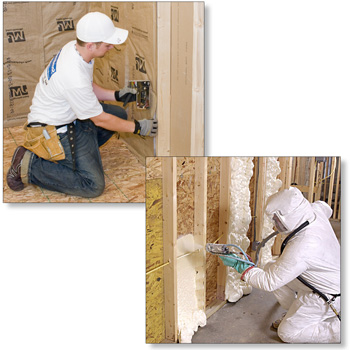This is a common question, and perhaps the answer is surprising. When we’re looking to soundproof a partition (wall or ceiling) we’d like to introduce absorption in the otherwise hollow wall or ceiling cavities. Hollow, sealed cavities will have generate an unwanted resonance. Open or closed cell foam is a common consideration, but not appropriate for soundproofing. For damping the resonance in the air cavity, we prefer medium density fiberglass, cellulose, cotton, mineral fiber or polyester. All of these are open and “airy” enough to adequately interact with the sound waves in the sealed wall (or ceiling) cavity.
Foams are not adequately open. “Open cell” foam is certainly better than closed cell foam, but not as high performance as something like fiberglass or mineral fiber. Additionally, foam can “couple” the two sides of a wall or floor, allowing much better conduction of the vibration from surface to surface.
Clik here to view.

Foams are superior from a thermal perspective, but not a sound isolation perspective.
This might surprise some here, but when using insulation IN a wall or ceiling, it doesn’t get any better than standard thermal insulation in a low / medium density, especially to control low frequencies. This could be fiberglass or medium density mineral fiber. Canada NRC Lab Data This extensive lab report conducted by the Canadian government has relevant data.
Seems counter-intuitive, and there are many companies that capitalize on this intuitive aspect of insulation as a solution to sound control. Also counter-intuitive, we never want to compress / compact (stuff) the insulation. The greater the compaction, the greater the conduction of vibration from one side of the partition to the other. Again, we are describing the insulation IN a cavity, not ON a wall. Two different sets of physical parameters.
Further, there are only The 4 Elements of Soundproofing that we can bring to bear:
- Decoupling
- Absorption (insulation)
- Mass
- Damping
Of these 4, absorption brings the least to the table. We certainly want to install insulation where we are able, but know that the other 3 elements provide more demonstrable improvement.
